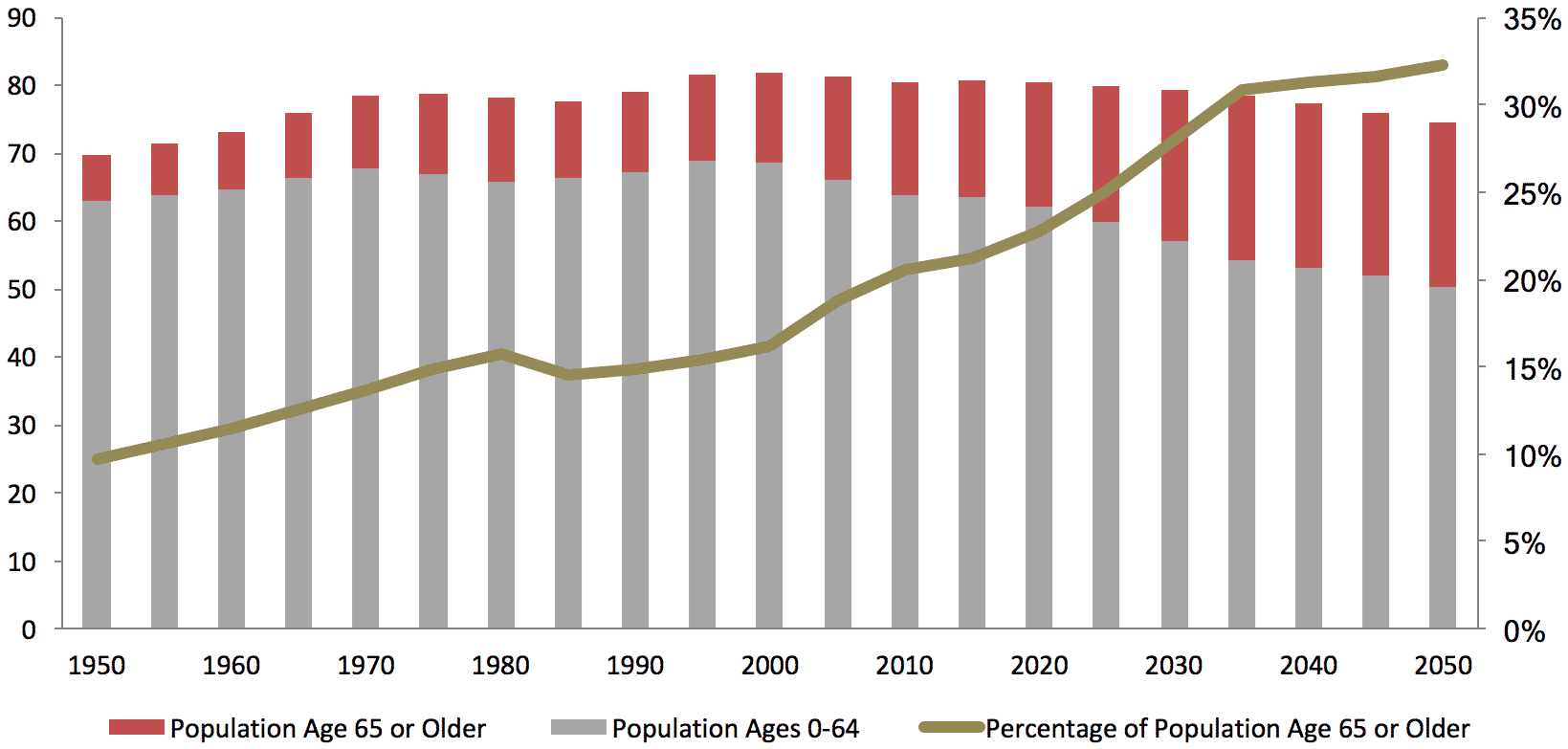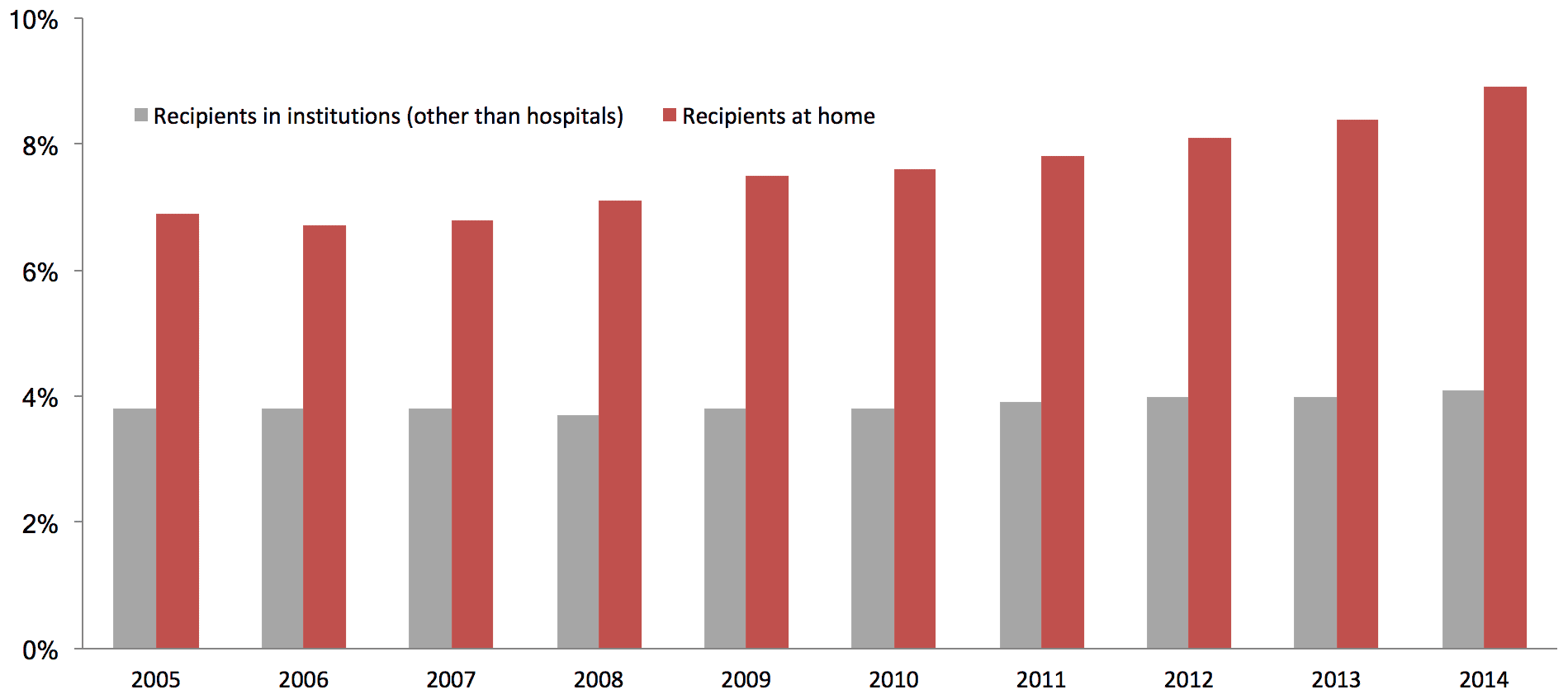Germany is currently one of only five “super-aged” societies in the world, and its population of those age 65 and older will continue to grow, reaching nearly one-third of the total population by 2050. In light of this demographic shift, German policymakers are working to increase labor force participation among older adults through various training and education programs as well as retirement system reforms. While labor force participation is still relatively low, Germany’s older adults have high levels of volunteerism, partly thanks to the government’s endeavors to create various opportunities for older adults to remain active in their communities.
Germany is a leader in leveraging digital technology to accommodate a healthier and more engaged older population, and the government has established programs geared toward helping older adults gain the necessary skills to use basic technologies. The country’s healthcare sector has begun to embrace e-health solutions as a part of a broader effort to improve service to the older population. Germany is also one of the few countries with mandatory long-term care (LTC) insurance. In order to address the growing need for care, the government has been working to broaden the scope and inclusivity of its LTC system, placing particular focus on improving conditions for both recipients and providers of home-based care.
Population by Age Group (in Millions) and Percentage of Older Population Age 65 or Older

Germany’s population age 65 and older is projected to grow by 41 percent to 24 million by 2050, accounting for nearly one-third of the total population. At the same time, the population ages 15 through 64 will shrink by 23 percent – from about 53 million in 2015 to about 41 million by 2050.
Source: UN Population Division

Community Social Infrastructure
The older population in Germany is highly independent and engaged. Volunteerism is growing, thanks in part to government-sponsored programs that help connect older people with volunteer opportunities that take advantage of their unique experience and skills. Both government and non-government organizations (NGOs) have also used cross-generational interaction as a way to provide community support to older adults. Innovative programs include shared living between older and younger people, and the pairing of nursing homes with elementary schools.
In 2014, more than 45 percent of people ages 50 through 64 engaged in volunteer work, and 34 percent of seniors age 65 and older did the same – equivalent to an 11 percent increase from 1999, greater than all other age groups apart from those ages 14 through 29.
Senior Citizen Offices (“Seniorenbüros” or SCOs)
The Senior Citizen Offices in Germany have been crucial to supporting older adults who want to get involved, by connecting them to volunteer opportunities. First established in the 1990s, it was a product of a social and political effort to change the negative image of aging that dominated German society in the late 1980s and early 1990s. The SCOs provide a wide range of volunteer opportunities relating to culture, the environment, politics, health, and social affairs for those interested in staying active after retiring. During the first five-year model phase of the program, there were only 44 SCOs in place, but the number has since grown to about 380. Over 28,000 people volunteer with the help of SCOs across Germany, and together they contribute about 2.5 million hours each year.
“The Senior Citizens’ Offices have provided many volunteers, and especially during times when Germany has had a lot of refugees. They are part of a greater initiative which encourages different generations within society to look out for each other.”
– Lena Dorin, Health and Long-Term Care Senior Policy Officer, BAGSO
Until recently, Germany has lacked national regulation to ensure accessibility in buildings and transportation, which have significant barriers to safe mobility and access. New legislation in 2013 set the goal of barrier-free public transportation by 2022. The government is also working to adapt the country’s housing stock to aging, with an Age-Appropriate Rebuilding program. Demand was so high that the EUR 49 million (approximately USD 55 million) in funding for 2016 was exhausted only halfway through the year.
Productive Opportunity
Germany’s older adult labor force participation rate remains low but is growing rapidly. Germany’s “baby boom” generation will begin to reach the retirement age of 65 in 2019, which will set off a dramatic acceleration in the shrinking of its labor force. In order to address this, the government has undertaken retirement reforms, including raising the pensionable age and introducing flexible retirement options, and has established programs to provide employment opportunities, education, and training, and to improve workplace conditions for older employees.
While the population of those ages 15 through 64 in Germany experienced a 2.2 percent decrease from 2005 through 2015, the figure will fall by an additional 22.6 percent by 2050 – equivalent to over 10 million individuals.
The labor force participation rate among Germans age 65 and older grew from 3.4 percent to 6.1 percent between 2005 and 2015, though it is still considerably lower than the OECD average of 14.1 percent. Today, older Germans’ labor force participation is below those of all countries observed in this study.
The Federal Initiative New Quality of Work (INQA)
The German government has been working to ensure that older adults receive the appropriate support within their place of employment through the Federal Initiative New Quality of Work (INQA). Since 2002, the Federal Ministry for Employment and Social Affairs has been dedicating resources and funding to improve the quality and sustainability of work, with a particular focus on older adults. INQA works with firms to develop and use human resources in ways that are more accommodating of the needs of older adults. Strategies include promoting foresight of training needs within companies, establishing lifelong learning activities, encouraging knowledge exchange among different generations of workers, and the general promotion of diversity management and inclusivity. Its goal is to effectively assist 4,000 employers and 2 million employees. This program is especially helpful for small and medium-sized enterprises (SMEs), which make up 99.5 percent of all enterprises in Germany and have relatively limited HR capacity.
“INQA provides information for companies on how to assess their situation and how accommodating their environments are for a diverse range of employees. That’s highly important, since one might say there is still a lack of measures to ensure high standards in this way in SMEs, partly due to their small HR departments, where the majority of Germans work."
–Jürgen Bauknecht, Coordinator of Employment, Business and Technology Research at the Research Association for Gerontology of the Technical University of Dortmund
Technological Engagement
Older German adults stand out for their high levels of technology adoption − the vast majority are using the Internet at least once per week. The country is also leading in the development of specific technologies intended for older adult use, such as Ambient Assisted Living (AAL) technology, which is intended to assist older people in functioning independently. The government has focused both on increasing access to technology, as well as further developing innovative technological solutions to assist the older population in their daily lives. Interesting models have emerged for enhancing digital literacy, helping older adults take on a more active role as collaborators in training their peers in the skills needed to use basic technologies.
Germany’s Ambient Assisted Living sector is growing rapidly, with its revenue expected to reach about EUR 252 million (approximately USD 283 million) by 2020 despite being just about EUR 54 million (USD 61 million) today.
About 67 percent of all those age 65 and older were using the Internet every day or almost every day by the first quarter of 2016, while 23 percent used it at least once per week.
Innovations for Municipalities and Regions in Demographic Change (“InnovaKomm“)
In 2014, the German Federal Ministry of Education and Research launched a competition among local organizations and municipalities to spur innovation geared toward improving the quality of life for older adults, not just in their homes but in their communities as well. The “Innovations for Municipalities and Regions in Demographic Change” competition (InnovaKomm) has EUR 23 million (approximately USD 26 million) to support the ongoing success of the selected project proposals through 2020. The five winning projects that were launched in 2015 focused on improving media competencies, improving public transportation, developing a digital communications network, developing a healthcare-related project for rural areas, and supporting urban living for older residents. One of the funded projects, MobiSaar, is focused on developing a comprehensive mobility service for older adults across Saarland by compiling and evaluating real-time information on stations, buses, and sidewalks. The information will be accessible by a hotline or a smart phone app in order to enable easy travel planning. For longer distances, the project’s service center provides volunteers to assist older people with their journey to the train station or bus stop. Another initiative, UrbanLife +, is focused on deploying smart technologies to enhance safety for older people. It has done so by installing street lamps that adjust their brightness to the eyesight of pedestrians, and sensors at junctions and other critical areas to alert them to potential dangers caused by road traffic or other sources.

Healthcare & Wellness
The super-aged population in Germany has a high healthy life expectancy, with three-quarters of those age 65 and older reporting that they still feel fit. However, the prevalence of chronic conditions and psychological conditions like dementia is growing and driving demand for long-term care (LTC) to increase substantially. Germany is an early mover in requiring LTC insurance and is also working to strengthen home-based care and to widen the scope of beneficiaries, with particular emphasis on the population with dementia. Policies have also endeavored to improve the quality and affordability of care. The government is also focused on ensuring that older adults in underserviced rural areas have access to the same quality of care as in urban areas, leveraging e-health technology.
Only 7 percent of older people experienced cost-related access problems in 2014, and 81 percent of Germans age 65 and older receive care either the same day or the day after they request it.
Long-Term Care Recipients as Percentage of Population Age 65 or Older

As of 2014, more than twice as many older adults received long-term care at home as within institutions. From 2000 through 2014, as the need for LTC continued to grow, home care met 83 percent of new demand.
Source: OECD Statistics